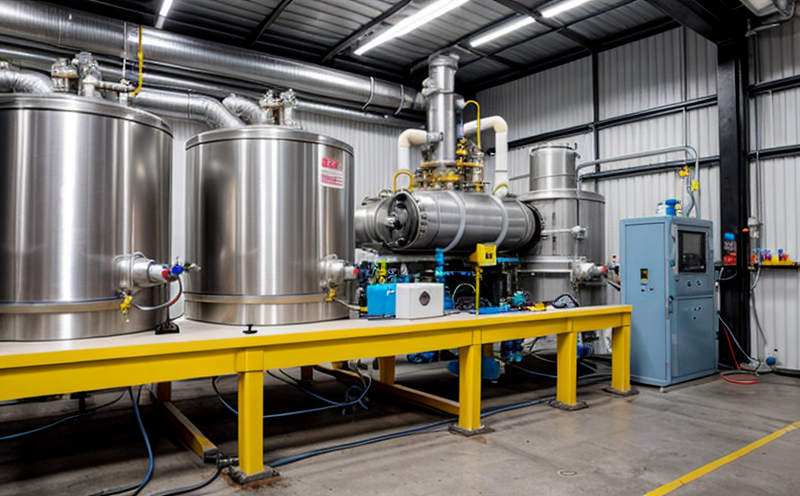ASTM E1005 Determining Neutron Flux Distribution in Reactor Vessels
The ASTM E1005 standard is a critical tool for ensuring the integrity and safety of reactor vessels within the nuclear industry. This method determines the neutron flux distribution at various points inside reactor cores, which is essential for optimizing fuel performance and enhancing plant safety.
Neutron flux distribution refers to the spatial variation in the number of neutrons per unit volume and time throughout a reactor core. Understanding this distribution allows engineers and scientists to identify areas with high neutron density, which can lead to excessive wear on materials or potential hot spots that could compromise the structural integrity of the vessel.
The ASTM E1005 method involves the use of various techniques including the insertion of boron carbide (B4C) samples, which are irradiated within the reactor. These samples absorb neutrons and generate gamma rays that can be measured to determine the neutron flux at different locations in the vessel. This process is repeated for multiple positions within the core to generate a comprehensive map of the flux distribution.
The accuracy of ASTM E1005 is paramount, as it directly impacts reactor performance and safety. Inaccurate flux distributions can lead to suboptimal fuel usage or potential hazards during operation. The standard provides precise instructions for sample placement, irradiation time, and measurement techniques to ensure that the results are reliable.
One of the key aspects of ASTM E1005 is its application in real-world scenarios. For instance, it helps in the design and optimization of new reactor designs by providing data on how neutrons behave within different configurations. This information can be used to predict potential issues before they occur, thereby reducing maintenance costs and increasing operational efficiency.
The ASTM E1005 method is also crucial for compliance with international safety standards and regulations. By accurately determining the neutron flux distribution, facilities can ensure that their operations meet stringent safety requirements set by organizations such as the International Atomic Energy Agency (IAEA) and the Nuclear Regulatory Commission (NRC).
In summary, ASTM E1005 is a vital method for ensuring the safe and efficient operation of nuclear reactors. Its ability to provide detailed information on neutron flux distribution makes it an indispensable tool in the field of radiation and nuclear testing.
Why It Matters
The accurate determination of neutron flux distribution is essential for maintaining the integrity and safety of reactor vessels. The distribution of neutrons can vary significantly within a reactor core, with some areas receiving higher doses than others. This variability can lead to premature wear on materials, increased radiation exposure for personnel, and potential safety hazards.
ASTM E1005 provides a standardized method for measuring this flux distribution, ensuring that all facilities follow consistent procedures. By using this standard, reactor operators can ensure that their vessels are being monitored in the most effective way possible. This leads to improved performance, increased efficiency, and enhanced safety.
The importance of ASTM E1005 extends beyond just monitoring current conditions; it also plays a role in long-term planning and maintenance. By understanding how neutrons behave within different reactor configurations, operators can make informed decisions about future upgrades or modifications to their facilities. This proactive approach helps to prevent potential issues before they arise, saving time and money in the long run.
In addition to its practical applications, ASTM E1005 also supports regulatory compliance. Many countries have strict regulations regarding nuclear safety, and accurate measurement of neutron flux distribution is often a requirement under these laws. By adhering to ASTM E1005, facilities can ensure that they are meeting all necessary standards and avoiding costly fines or other penalties.
The standard also fosters international collaboration by providing a common framework for testing methods. This allows different facilities around the world to compare results and share best practices, ultimately leading to improved safety protocols globally.
Applied Standards
| Standard | Description |
|---|---|
| ASTM E1005-18 | Determining Neutron Flux Distribution in Reactor Vessels |
| ISO 24376 | Nuclear power plants - Quality assurance for nuclear equipment and facilities |
| EN 50189 | Detection of radiation damage in reactor materials |
Scope and Methodology
The ASTM E1005 standard outlines a detailed process for determining neutron flux distribution within reactor vessels. The method involves the placement of boron carbide (B4C) samples at various points throughout the core, which are then irradiated under controlled conditions. Once exposed to neutrons, these samples absorb some of the incoming radiation and emit gamma rays as a result.
The emitted gamma rays are measured using specialized detectors, allowing for accurate determination of the neutron flux at each location. This process is repeated for multiple positions within the core to generate a comprehensive map of the flux distribution. The data collected during this procedure provides critical insights into how neutrons behave within different reactor configurations.
The ASTM E1005 method also includes specific guidelines regarding sample preparation, irradiation time, and measurement techniques. These detailed instructions ensure that all results are consistent and reliable, regardless of the facility performing the test. The standard further emphasizes the importance of proper calibration and quality control measures to maintain accuracy throughout the testing process.
In addition to its practical applications, ASTM E1005 also plays a role in long-term planning and maintenance by providing information on how neutrons behave within different reactor configurations. This data can be used to make informed decisions about future upgrades or modifications to facilities, helping prevent potential issues before they arise.





